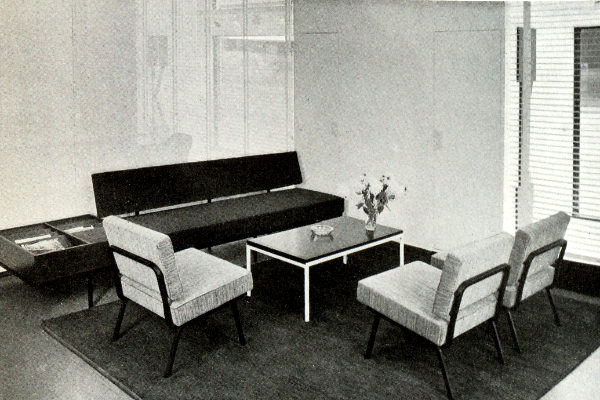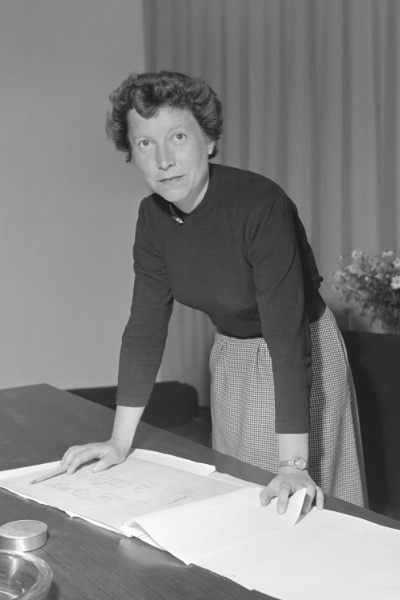
Biography
When Susanne Radermacher was born in Vienna in 1911 to Ludwig Radermacher, a university professor and classical philologist, and his wife Luise Ottilie Seeck, it was not yet clear what an exciting and eventful life she would have. The family had moved to Vienna from Germany in 1909, after Ludwig Radermacher had succeeded Theodor Gomperz as full professor of classical philology. She grew up in a villa in the elegant 18th Viennese district of Währing. Having grown up in an academic environment, she too decided to study. As the Adolf Loos family were close friends of the family, this may have inspired Susanne Radermacher’s career aspirations.
She initially studied at the Kunstgewerbeschule (School of Arts and Crafts), taking courses in interiors and residential buildings in 1929/30. In the catalogue of the Kunstgewerbeschule, which lists all students of the respective years and notes the direction of their training, she was attested a clear attitude towards all questions of housing, although with the note that she still had to work on the technical issues. Her nature was described as energetic, but hard-working and diligent. In the following winter semester, Susanne Radermacher transferred to the Technische Hochschule. For the winter semester of 1932, there is a note in the student file of a deregistration to the TH Berlin, dated 14 November 1932. Nevertheless, she passed the 1st state examination in Vienna exactly 1 month later. Regular examinations at the TH Vienna are also noted. Unfortunately, no study records exist for her time in Berlin. In any case, she successfully completed her studies in Vienna on 10 July 1935.
In the years following her graduation, she worked in several architectural firms in Vienna and Berlin in the fields of urban planning, building and furniture design. The growing influence of the Nazis worried her. After the so-called Anschluss of Austria to the German Reich, Susanne Radermacher decided to leave the country. She first went to Denmark, where she had already been as a child after the First World War. She travelled on to Stockholm with a recommendation letter and found work in the architectural office of Sune Lindström and Ivar Ståhl. It was here that she met the Canadian architect Arnold Wasson-Tucker (1909-1995), whom she married in 1939. A year later, the couple decided to move to the USA, partly out of fear of an expansion of the war that had begun in 1939.
She immediately found work as an assistant to Aino and Alvar Alto, the Finnish architect couple and pioneers in the field of Scandinavian design, in the Finnish pavilion at the World’s Fair in New York.
After the end of the World’s Fair, Susanne Wesson-Tucker followed her husband to Boston, where he found a job at the Massachusetts Institute of Technology (MIT). While her husband was employed, she first had to find a new job. Marcel Breuer, to whom she had applied, used his contacts to help her get smaller commissions, and she also worked on exhibitions at the Peabody Museum at Harvard University.
From 1941 to 1943, she was a partner in the Finnish furniture company Artek in Boston, which experimented with the design of inexpensive furniture. She also lectured on furniture design and interior decoration to students at various decorating schools and, like her husband, at MIT.
In 1943, her Arnold Wasson-Tucker was drafted into the Canadian armed forces and Susanne Wasson-Tucker moved to New York. She became the curator for industrial design at the Museum of Modern Art (MoMA) in 1944 and assistant to Serge Chermayeff, a Russian-English architect who had emigrated to the USA in 1940.
Exhibitions were to become a completely new field for Susanne Wasson-Tucker. Her first documented work as an assistant in the exhibition field was Art in Progress: 15th Anniversary Exhibitions: Design for Use in 1944, followed by Tomorrow’s Small House, about an urban planning concept in North and South America, also at MoMA. After the end of the war, she and Serge Chermayeff conceived a solar house, a visionary plan for sustainable building as part of a modern, new lifestyle.
She then began to be active for the Knoll company. At first, she was responsible for the interior design of the American embassy in Cuba, followed by the embassies in Copenhagen and Stockholm from 1951-1959. The embassies were furnished with modern American furniture designed by the architects Eero Saarinen and Charles and Ray Eames. This new professional step was accompanied by a new personal one. Her husband went to Mexico as technical director of Knoll International, she decided to move to Sweden after her divorce and stayed there.
Her freelance activity was important to her, as she had realised that institutional freedom was essential for the creative process of a designer. She worked as an exhibition architect for the Svensk Form Design Centre in Stockholm, designed furniture and furnishings for the departments of Nordiska Kampanit, the most upmarket department stores’ in Stockholm, which was known for focusing on new trends and innovations, and for the Foresta Hotel on Lidingö, a revolutionary flat hotel at the time. Other important commissions included the design of the art section of H55 in Helsingborg in 1955, an important trade exhibition for architecture, industrial design and home textiles, which brought Scandinavian design a great deal of international attention. In the 1950s and 1960s, she designed a number of Swedish design exhibitions abroad, including the Swedish pavilion at the Milan Triennale in 1957 and the home section at Le Maison Ideale in Brussels in 1965.
In addition to organising design exhibitions, Susanne Wasson-Tucker designed interiors for aircraft such as for Scandinavian Airlines and Malaysia-Singapore Airlines.
Wasson-Tucker’s designs, which were not subject to fashion trends but remained true to her modernist, timeless style, were very chic in their day. She was reappraised in the 2000s. Susanne Wasson-Tucker died in Stockholm in 2008.
Works (selection)
1944: Art in Progress: 15th Anniversary Exhibitions: Design for Use, Exhibition at the Museum of Modern Art, New York
1944: Useful objects for under 10$, Exhibition at the Museum of Modern Art New York
Tomorrow’s Small House, Exhibition at the Museum of Modern Art New York
1945: Concept of a solar house (with Serge Chermayeff)
1945: Integrated Buildings: Kitchens, Bathrooms, Storage. With Elizabeth Mock und Greta Daniel
Furniture design for Nordiska Kampanit
Interior design for the Foresta Hotel on Lidingö
1951-1959: Interior design of the American embassies in Cuba, Copenhagen and Stockholm
1955: Design of the art department of H55 in Helsingborg
1957: Design of the Swedish pavilion at the Triennale in Milan
1965: Design of the interior department at Le Maison Ideale in Brussels
1970s Jahre Interior of Scandinavian Airlines and Malaysia-Singapore Airlines aircrafts.
Sources
Archive UaK / Art Collection and Archive, University of Applied Arts Vienna, Nationale Susanne Radermacher 13.10.1920
Press release: The Museum of Modern Art: Museum of Modern Art opens small permanent gallery of architecture and industrial design, (no date), https://www.moma.org/momaorg/shared/pdfs/docs/press_archives/961/releases/MOM iN. MOMA-archive, A_1944_0047_1944-11-13_441113-39.pdf, (retrieved 10.10.2023)
Letter from Susanne Wasson-Tucker to Marcel Breuer, 23 October 1940, in: Marcel Breuer Digital Archive, Special Collections Research Center at Syracuse University Libraries, https://breuer.syr.edu/xtf/view?docId=mets/3068.mets.xml;query=;brand=default (retrieved 07.09.2023)
Heidy González Gómez: Susanne Wasson-Tucker 1911-2008, in: Una día / Una arquitecta, https://undiaunaarquitecta3.wordpress.com/2018/01/23/susanne-wasson-tucker-1911-2008/ (retrieved 29.12.2023)
Hedvig Hedqvist: Susanne Wasson-Tucker, in: Svenskt kvinnobiografiskt lexikon, https://www.skbl.se/en/article/SusanneWassonTucker0 (retrieved 29.12.2023)
https://de.wikipedia.org/wiki/Ludwig_Radermacher, (retrieved 03.01.2024)
Daniel A. Barber: Architecture and Sufficiency: A Case Study in Applied History, in: Art Papers, https://www.artpapers.org/architecture_and_sufficiency/ (retrieved 12.11.2023)
Foto: Portrait, ©: Nordiska museets arkiv. NMA 0107321
Foto: Interior:. ©: Nordiska museets arkiv.
Text: Christine Oertel
January 2024

